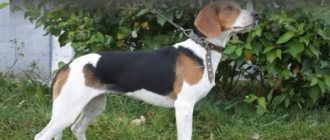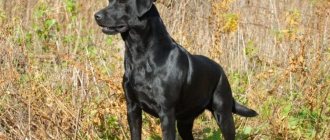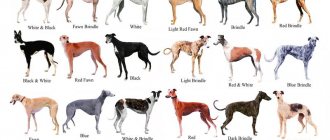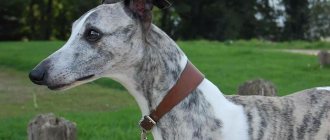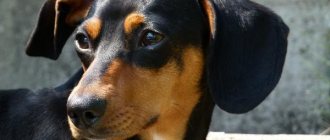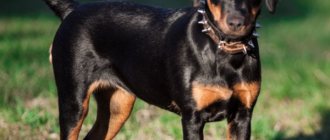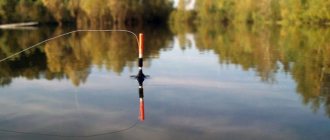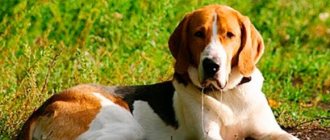general information
The Estonian Hound was first standardized in 1954.
As a result, in 1966 and 1981, some changes and amendments were made to the register, which gave more accurate characteristics of the breed.
Consider the constitution of the animal's body:
- The dog's height is below average;
- Body structure – dry and elongated;
- The height of the breed at the withers is up to 52 cm;
- The dog has a calm behavior and prefers an active lifestyle;
- The stretch index of dogs is about 110-112 cm.
Among the shortcomings of the constitution are the following:
- High, raised butt;
- Small dimensions.
Often, the animal’s body deviates from the standards, both in length and height.
Other positive features of hounds include a lean, muscular body with healthy skin and short, stiff hair to which weeds do not stick.
Description of the Estonian hound
The standard positions the Estonian hound exclusively as a hunting dog, helping in hunting on foot small animals (fox, hare, etc.) and birds . Hounds work well on the scent. Recently, more and more often they are kept as watchmen and security guards, as well as companion dogs.
Appearance
The Estonian Hound is a small, extremely active and energetic dog with a strong, but elegant, graceful and lean physique with strong solid bones and well-developed, prominent muscles. The body is rectangular in format (extension index for males - 108–110, for females - 110–112) with an extended straight back, well-developed and prominent withers, deep, elongated, oval, sternum dropped to the elbows, convex, wide short loin and moderately toned , raised in the direction of the croup by the underline. Sexual dimorphism is pronounced, females are noticeably smaller and lower.
The physique of the Estonian Hound is dry, graceful and elegant.
Breed standard:
- Height at withers: females - 42–49 cm;
- males - 45–52 cm.
The Estonian hound moves smoothly and elastically, pushing well with its hind legs and swinging its front legs far. All movements are energetic, free and straightforward.
The Estonian's movements are smooth and elastic
The coat is hard and short, evenly fitting the body and shiny with a poorly developed, poor undercoat. On a general white background there are black and colored spots of different sizes (as bright as possible).
Acceptable colors:
- yellow-piebald;
- scarlet-piebald;
- black-and-white;
- brown-piebald with tan;
- black and tan with tan (the most common).
White markings are allowed on the chest, throat, head and belly. The end of the tail and all legs should be white.
The Estonian differs from its direct relative, the beagle, in having a more slender and graceful physique, as well as being taller.
The Beagle is stockier. strong and short-legged
Disadvantages and disqualifying vices
Faults or minor defects are considered to be any deviations from standard breed characteristics; their severity is assessed depending on the degree of manifestation and their impact on the well-being, well-being and health of the animal.
Vices and more serious shortcomings will be:
- body is too long or short;
- raised pelvis;
- flattened or convex skull;
- abnormal pigmentation of the eyelids, lips and nose;
- undershot (small);
- eyes are small or bulging, light iris;
- ears set above the eye line are thick, short or furry;
- pendant around the neck;
- chest sideways, flat or narrow;
- weak back, hunchbacked or sagging;
- a twisted or broken tail, with a large dewlap or sparsely covered with hair;
- improper development of limbs;
- the coat is long or very short, wavy, complete absence of down;
- color that does not correspond to the standard (brown, strong speckling, etc.);
- rough or very light build;
- excessive excitability or timidity.
The grounds for disqualification are:
- too tall;
- problems with the jaws (underbite, overbite);
- blue iris, different eye colors;
- ears erect, raised or very small;
- serious defects in the tail (kinks, tilting to the side, etc.);
- lack of white in color;
- weak sexual dimorphism;
- obvious deviations (physical and mental) from the norm;
- cowardice or aggressiveness.
It is extremely important that the dog behaves adequately at exhibitions and field trials, does not show anger, but does not cling to the owner’s legs. Experts reject such individuals immediately. A good friend of ours had a wonderful hunting dog (drathaar), who would panic and, one might say, go into hysterics (which manifested itself in restlessness and endless barking) as soon as the owner moved far enough away from him.
Character and psyche of the breed
The Estonian Hound has a soft, flexible and good-natured character, as well as a calm and balanced temperament . The dog is endlessly devoted to his owners, especially worshiping one, the most important one, whom he obeys unquestioningly. He is very patient with children, enjoys playing with them, taking an active part in various pranks. But he does not tolerate loneliness well, filling the space with continuous barking. It is better not to get this breed for people who are very busy and often absent from home, so as not to injure the nervous system of the dog and neighbors.
The Estonian Hound gets along well with children of all ages.
A friendly pet will never become a good guard and watchman, since in most cases it perceives strangers very positively, even allowing itself to be petted right away. He can notify household members of the arrival of guests with a joyful bark, but that’s all he can do. He is loyal to other pets because he has a pack history. He can become friends with his cat if he grew up with her. But small animals and neighboring cats remain objects of hunting for him, which he will inevitably chase after as soon as the opportunity arises.
Timely and early socialization will allow you to avoid many problems in communicating with your own kind and strangers.
Energetic, playful and extremely active animals are completely unsuitable for lovers of passive recreation. For these hounds, the best owners will be athletic and active individuals, with whom the pets can get the necessary level of physical activity.
Features and Productivity
Hunting with Estonian hounds, according to many experts, will be unproductive in dense forest areas.
The fact is that such dogs will not climb into wide and deep holes (the maximum crawling depth is no more than 70-100 m). But there are also advantages...
In modern hunting realities, there are fewer and fewer places where you can safely hunt with hounds.
But even taking this factor into account, 50-100 km from Moscow or St. Petersburg there are still enough places where you can safely hunt foxes, hare and other animals.
For example, the same hare gets along well near roads, holiday villages, power lines, small forests, etc.
Hares calmly get used to people and domestic dogs, they easily deceive foxes and often feast on garden “treats”. It is in such conditions that a hound dog is ideal for hunting.
It is precisely in such conditions that there is a shallow crawl, which Estonian hounds love so much - the work is done in contact with the owner, with a tendency to search for a trace.
The main feature is that in such places there are practically no trails; you need to know the area and be able to work together with a dog. Often, the dog requires control.
That is, it is necessary to hold her at the bed or take her away from the same mushroom pickers, village dogs and others so that she does not lose the trail.
Almost all representatives of this breed are very sensitive to the owner’s demands and easily follow him, changing the direction of the search.
The second and rather unpleasant point is that you can’t get into a race with an “Estonian”. The breed does not belong to the category of super-fast and prefers to follow the scent.
The hare breaks away from her and turns the hunt into a long pursuit, confusing tracks on roads, railway tracks and in villages.
The “pedestrian” hound does not frighten the hare much and forces him to hide in a spruce forest or bushes, which makes him an excellent prey for the hunter, while the dog itself remains calm.
Having accustomed it to shooting in a timely manner, you can make a dog into an excellent hunting assistant.
As for the rut, as a rule, the hare goes ahead of the hunter with a gap of 5-10 minutes.
A race with a lead of 1-2 minutes is an exceptional rarity and requires the shooter to have extraordinary intelligence, skills, the ability to choose a suitable hole and dexterity.
Often, the hare runs out from a completely different direction and moves further away from the pursuit, which forces the hunter to start the chase again.
This dog is convenient for hunting in tandem. Her role is to track and drive the hare, while the two shooters are located in different positions, which significantly increases the firing radius.
Often, you come across seasoned hares who have already escaped from being chased. Hunting such animals is much more interesting, due to the unpredictability of their actions.
But there is one significant drawback - you can chase a seasoned hare with an Estonian hound all day and ultimately never achieve the desired goal.
The Estonian hound dog has one significant drawback - in urban conditions it turns into a sissy and completely loses interest in hunting.
Even breeding this breed in such conditions will not give a positive result - hound puppies will become the same kind of domestic decorative dogs (you will have to buy a new dog).
In general, the breed is very good and promising - there are a lot of hares in the forests. And those who are interested in other prey can try fox hunting, which a dog of this breed searches for and even catches just perfectly.
Caring for the Estonian Hound
Estonian women adapt equally well to life in an apartment and in a country house . In the first option, they need to be walked at least twice a day for an hour and a half, giving them the opportunity to run and frolic. In the second case, you will need to install a good and durable fence around the yard or enclosure, because hounds jump very well, despite their small stature, and also dig tunnels passionately and skillfully. Dogs cannot be kept outdoors all year round, because their fur is short and does not provide warmth. During the cold season, animals are transferred to a heated room.
Basic care is as follows:
- for short fur, it is enough to comb it once a week with a special brush or silicone mitt to remove dead hair (daily during the molting period);
- bathe 1-2 times a year with zoo shampoo for short-haired animals;
- wipe the eyes with tea leaves or herbal decoction every 3–5 days;
- Ears are examined weekly and cleaned using veterinary lotion;
- once every 5–7 days, use a brush (finger attachment) and special toothpaste for animals to clean their teeth;
- The claws are trimmed with a nail clipper about once a month (if they do not grind down on their own).
It can get boring in a hound's apartment
Estonians are not picky when it comes to nutrition; they can be given both homemade food prepared especially for them, and ready-made store-bought freeze-dried formulations intended for active dogs of medium build. Adults are fed twice a day, puppies are given food from 3 to 6 times depending on their age.
The natural diet includes the following products:
- raw lean meat (horse meat, rabbit, etc.);
- offal, entrails, trimmings, cartilage;
- vegetables, greens;
- boiled fish;
- fruits, berries;
- porridge (rolled oats, rice, yachka, etc.);
- eggs;
- fermented milk products (cottage cheese, fermented baked milk, yogurt, etc.) with low fat content;
- unrefined vegetable oil;
- vitamin and mineral supplements.
It is forbidden to feed dogs fatty, smoked, peppered, highly salted and spicy foods, as well as sweets, baked goods, canned food and tubular (chicken) bones.
Training
Smart and quick-witted Estonians are easy to learn and quickly master commands . You need to start raising and training a puppy from the first days of its arrival in the house. Hounds can be stubborn and independent, so only an experienced dog breeder who will be an unquestioned authority for the dog should work with them. It is better for beginners not to get involved with such dogs for now. Basic obedience courses take place at 5–6 months.
The breed is distinguished by its early maturation; some individuals easily earn field diplomas as early as 7–8 months.
Estonian hounds start hunting very early
It is better to entrust further training, as well as training (training) with work in the field, to a professional canine trainer.
Estonian hounds can participate in various dog competitions (agility, freestyle, etc.).
A few final words
This breed is ideally suited to domestic hunting conditions in many ways.
The dog responds well and does not run far from the owner (there is no need to waste time on shouting, swearing, searching and shooting, which will help attract the attention of a hunting dog, which is very convenient in our dense forests).
The small size of the dog allows you to carry it even in a backpack. It also won’t take up much space in the car, which is extremely attractive.
With such a dog you can hunt right in your summer cottages - the breed looks friendly, attractive and cute, which will not frighten even a small child.
Also, its small size will help you slip through even narrow gaps in the fence, which is very convenient when chasing a target.
A final fly in the ointment:
- In winter, “you can’t cook porridge” with such a dog. Small power parameters compared to the same Russian hound and small stature make it useless in winter. In the spring, the breed also proved itself to be not a very reliable assistant;
- This breed is not patient and will not be able to lead an animal for several hours. This is uncharacteristic for her. The chance of catching prey is significantly reduced.
As a result, we can say just a few words - the Estonian hound will definitely find its fans in our country and will help many hunters achieve their desired goal.
What can you tell about the dog's character?
The dog from Estonia is a hunting greyhound with a sharp mind. During the hunt, very often the dog shows too obvious aggression towards the animals. But at home she is calm, gentle and affectionate.
The dog will come to the owner at the first call and carry out his orders. Owners note the following advantages of the dog:
- energy;
- devotion;
- early readiness to work;
- malice towards the animal while hunting;
- obedience.
However, the future owner needs to be aware of the tendency of dogs of this breed to bark. Animals can bark loudly and non-stop. However, this problem can be reduced with training. It should be taken into account that the animal needs a long walk, which is very important for its health.
The Estonian hound breed received its standard in 1998.
You can be sure that the Estonian hound, descriptions of which can be found in magazines and newspapers, will bring a lot of emotions and positive impressions to the life of the owner.
Photo gallery
We talked in detail about all the positive and negative aspects associated with the use of Estonian hounds in hunting. And now we offer you a small selection of photos for viewing.
Diseases of the Estonian Hound
Estonians are considered healthy dogs that do not suffer from any congenital genetic diseases. Rarely occurring diseases of the musculoskeletal system (arthritis, articular dysplasia, etc.) are caused by an improper exercise schedule, prolonged hypothermia, excess body weight or errors in diet. Ear problems (otitis) occur with inappropriate care.
These small hounds can live for about 11–13 years, but there are often cases when a dog has crossed the 15-year mark.
Bottom line
If you want to buy yourself an assistant and don’t yet know which hunting dog is best for you, let’s give a few examples. If you want to buy a dog to hunt mainly hare and fox, then in this case you should pay attention to hounds and greyhounds.
It is worth noting that hunting with a hound is more interesting and requires more intervention from the hunter in the process. In addition, due to its smaller size, such a dog is easier to maintain. If you need a dog that will hunt not only fur-bearing animals, but also game birds, in this case you need to look towards the more versatile Drathaar.
How to choose a dog
Today, Estonian hound puppies are sold not only in Estonia. If you want to buy a puppy, it is better to go to a kennel. You can adopt a small dog as early as one month old.
It is imperative to ensure that the dog is active and healthy. The coat should shine. You need to find out from the breeder whether the dog has been vaccinated. If you want to buy a dog for hunting, you must make sure that it has working parents. Otherwise, the animal will not be suitable for hunting, as it may have a weak sense of smell.
You need to check your dog for fearfulness. You should throw coins or a bunch of keys on the floor. The puppy should not be afraid of an unexpected sound. The breeder must give recommendations for caring for the pet, which should be followed.
What you need to know about training and feeding a hound?
It is very important that the Estonian Hound easily accepts the training process. She is a fairly sociable dog. Therefore, beginners do an excellent job of training her. The most important thing is to socialize her and not use harsh punishments.
During training you need to give signals with a hunting horn. When the animal runs up, you should give it a treat. This skill needs to be consolidated, since it will be needed during the September catch-up. In autumn, traces of a hare leaving to lie down remain. The dog must find the animal and chase it. If an animal loses a hare, the hunter will definitely help him.
The owner should know that hounds are not picky eaters. You don't need to spend a lot of money to feed her. However, it should be remembered that the animal uses a lot of energy. Therefore, his diet should include foods rich in protein and calcium.
If you decide to use natural food, you should definitely include fats, dairy products, fat-soluble vitamins and meat in your diet. If it is possible to give your pet food, it is better to choose a special brand for hunting dogs. It is not recommended to combine dry food and natural products, as this can lead to deterioration in the animal’s health.
Hunting with hounds
In order to keep up with the hare at least during the rut, you need fast, agile and hardy dogs. The fact is that when a hare escapes from a predator, it tries to constantly change its trajectory of movement, thus slowing down the pace of pursuit.
Therefore, a good dog should not only catch up with the animal, but also be able to chase it for a long time. Among all dogs, these qualities are most closely matched by the hound breed. They are hardy, flexible and have good pursuit speed.
Due to its light weight, the hound is able to pursue prey for a long time, while other dogs get tired very quickly. And good charm allows the hound to effectively search for the hare. Of course, each hound breed has its own characteristics, which we will discuss below.
Diseases and health problems
It is very important for the future owner of an Estonian hound to know that this breed is very rarely susceptible to diseases and has a strong immune system. Also, these dogs live quite long - 10-14 years
The most common diseases characteristic of this breed, which are more due to high physical exertion during hunting and training, rather than poor health of the animals.
This is, first of all:
- Dislocations of limbs;
- Arthritis of the joints;
- Ligament ruptures;
- Otitis.
A rather serious danger for the Estonian hound, as a hunting dog that often works in the forest, is represented by ticks, which often carry a dangerous disease - piroplasmosis. To be on the safe side and avoid troubles of this kind, after a hunt, the owner must inspect and feel the animal for ticks, and if they are detected and the very first signs of illness (refusal to eat, lethargy, thirst, pale mucous membranes), quickly contact a veterinarian for help.
Other dangerous symptoms that may be harbingers of various diseases in the Estonian hound:
- Diarrhea;
- Vomit;
- High or low body temperature;
- Repeated refusal of food and water.
It is important to carry out preventive examinations of the Estonian hound at the veterinarian approximately every six months to check for hidden infections and other troubles. The veterinary clinic can also recommend what medications to purchase for first aid.
The veterinarian will give detailed instructions on what medications to stock in your home first aid kit and how to use them correctly.
Preliminary preparation
Before going out into the field and training a dog, as they say, in conditions close to real ones, you need to do some educational and preparatory work:
- To prevent the hound from knocking off its paws when it first goes out into the field, they must be well padded. To this end, about a month before the start of the hunt, when you go out with your dog for a walk, choose a hard surface (paved road, stone pavement) and walk at a brisk pace for half an hour. The speed of your movement should be such that the dog does not move behind you very quickly, but rather at a trot. As a result, the hound's soles will become stronger.
- The dog must be able to walk at the owner's feet or slightly behind him. In general, the best option is when, even without a leash, the dog follows all the commands of the leader, from prohibitions to crawling.
- The hound must be accustomed to the signals of the horn, not be afraid of it, but respond appropriately - for example, returning to the owner. The best time for training is the period before feeding.
- In the enclosure where your pet lives, the floor should be hard compacted with the addition of crushed stone or slag.
What you should pay special attention to
However, training is not all there is to think about. You also need to make sure that the hound chases the hare in conditions that are close to real ones. To do this you need:
- Show your dog the animal to awaken its instincts. The dog must understand that it needs to chase the hare, follow its trail.
- It is better to do this in the second half of spring - approximately from the end of April to the beginning of June. During this period, the air temperature is conducive to normal training. If you didn’t have time in the spring, then it’s better to start in the second half of August. Chasing a Russian hound after a hare when snow falls is not recommended, since the dog begins to follow the snow trail by eye - such a dog will then have difficulty working along the black trail.
- Look for areas specially designated for this purpose.
- It is better to chase the hare. After this, the hound will be able to work on the hare. If you start with hare, then you can switch to hare only after good practice and new training.
- It is not recommended to carry out training at night. The best time is dawn. You need to have a treat with you to caress the animal and feed it before the start. Next, using the commands “go forward”, “search”. You can help the animal by shouting and whistling.
Remember that your actions must be systematic and consistent, only then will the education of the animal have results. You need to work with the hound every day, only then will all reflexes be properly strengthened. Don't expect instant results - the dog may behave strangely for some time, but with increasing number of outings this will pass.
Appearance
The Estonian hound dog is a medium-sized working breed, although in fact, its size is smaller than average. When assessing the exterior, reduced height is acceptable, but exceeding it is considered a defect. The weight of an adult dog can range from 11 to 20 kg, depending on its build. Dimensions are assessed according to two parameters: height at the withers and elongation:
- Male: 45–52 cm; 108–110.
- Female: 42–49 cm; 110–112 (since the bitch must be able to feed the offspring).
Breed standard
The head is strong and weighty, but not coarse. The frontal part is not too wide, without excessive convexity. The occipital protuberance is smoothed, the eye sockets are not too elongated or heavy, but pronounced. The transition from the skull to the bridge of the nose is moderate, not sharp, but not smooth either. The bridge of the nose is straight; hooked or snub nose is considered a defect. The lips are fully pigmented, not dry, but tightly fitting.
The teeth are large, healthy, white, just the right bite and a complete set.
The nose is wide, mobile with wide nostrils, brown (in light piebald individuals) or black. Lightening of pigmentation, except when allowed, is considered a defect.
The eyes are almond-shaped, the inner corners are slightly lowered (slant cut), the eyelids are fully pigmented to match the nose, the irises are dark brown. Heterochromia, blue, pearl and light yellow eyes deprive the dog of show points.
The ears are long, lowered to the head, not heavy and low set. The tips are rounded, the outer lines of the ears are free from feathering. On examination, the ears should not appear raised on the cartilage, even if the dog is focused.
Body – without the slightest sign of weak bones or dampness of build. The neck is strong, oval in cross-section, set at medium height, carried with a pronounced angle. The withers are developed and rise well above the line of the back. The withers are 1–1.5 cm higher than the croup. The sternum is voluminous, one might say, barrel-shaped. The false ribs are well arched and pronounced. The chest is lowered to the elbows, but not lower. The loin is convex, wide, harmoniously extends the straight line of the back, the croup is neatly rounded.
The limbs are straight, dry, strictly parallel when viewed from the front and rear. The length of the front legs is half the height at the withers. The shoulders are well pulled back (more than 100°), the elbows are directed strictly back, and when viewed from the front, they are not tightly pressed to the chest. The forearms and pasterns are strong, smooth, oval in cross-section, and as vertical as possible. The thighs are dry but strong, the knees are at well-defined angles, the hocks are directed strictly back, the metatarsals are almost vertical to the support. If there are no comments on the dog’s exterior, a slight rise in the line of the back from the withers to the croup is allowed, which smooths out the line of the loin (not high rear). The hands are well compressed, oval in shape, the claws are bent to the ground. The toes should not look too long or thin; splayed paws are considered a fault, and in combination with hare feet, a fault.
Tail – looks thick due to the thick fur, but is free from fringes. Standing saber-shaped, the thickness gradually decreases from the base to the rounded tip. When working, the tail is carried raised, but not perpendicular. Wrinkles or severe curvature are considered a defect.
Coat type and color
The Estonian Hound should look muscular and fit. An adult dog does not have abundant folds of skin or dewlap. The guard hair is quite hard, perfectly smooth with a pronounced tint. Undercoat is present, but poorly developed. The fur is thick, especially on the tail. There should be no feathering on the muzzle, back of the paws, muzzle and ears. The spine on the tail grows thicker and visually thickens it.
The most common color is a combination of black, piebald and the so-called blush. Brown or crimson color in the same combination is allowed, but not brown or red-brown with a coffee tint. With piebald combinations, the size of the spots is not specified, but it is desirable that they look contrasting and harmonious. The sable color is acceptable but considered rare. Minimal speckling is acceptable in all colors.
